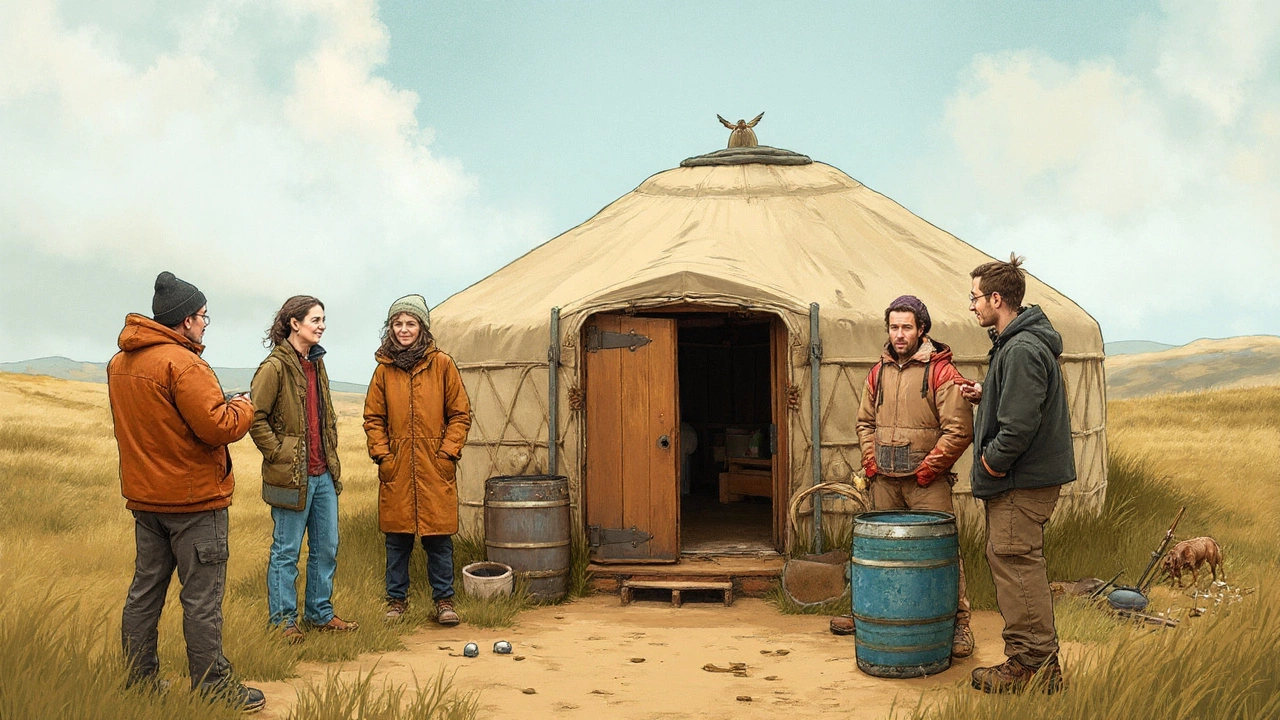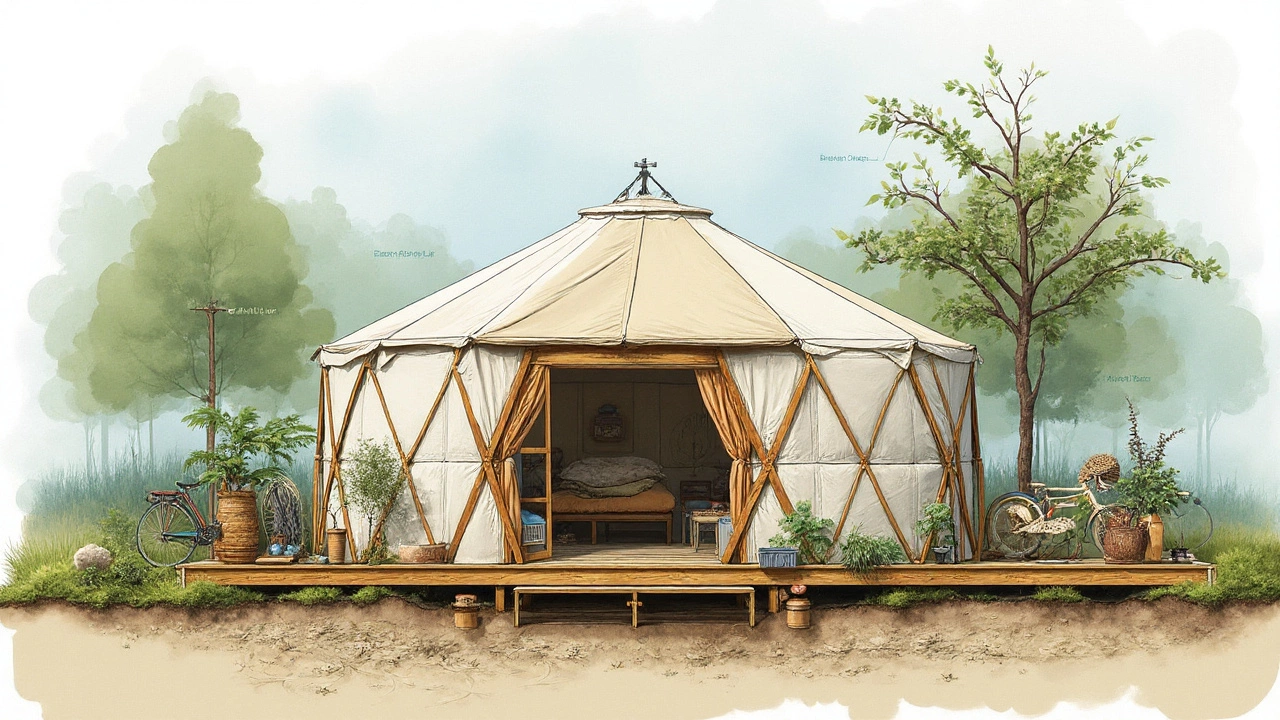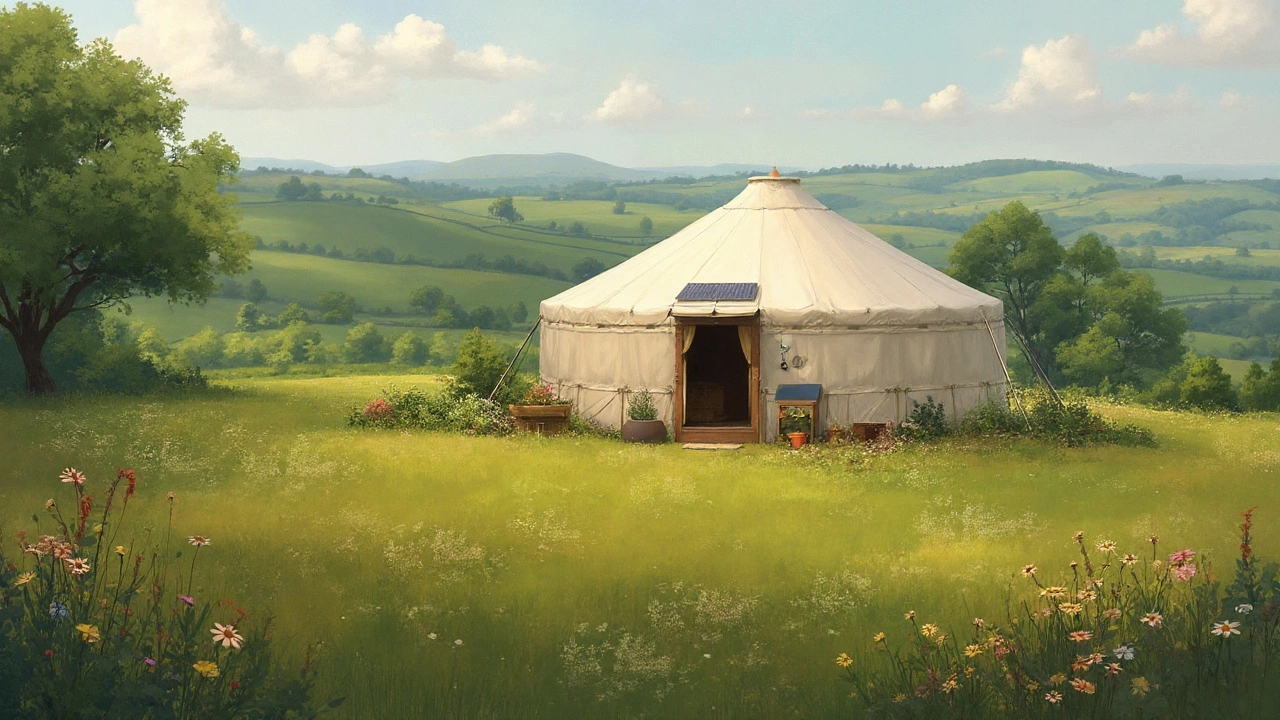Imagine waking up to the sound of rain tapping softly on canvas, surrounded by nothing but open land and sunrise creeping through a round skylight. That’s the magic of yurt living. These round, tent-like structures might look straight out of Mongolia, but they’ve made their way into hip eco retreats and off-grid communities everywhere. With climate anxiety climbing and everyone searching for better housing solutions, yurts pop up in glossy magazines and #cabinlife Instagram reels as the go-to for low-impact, green living. But are they really the answer for folks aiming to shrink their footprint, or is the hype just clever marketing and Pinterest dreams?
The Origin and Construction of Yurts: Built to Work With Nature
Yurts have been around for thousands of years, originally built by Central Asian nomads using whatever the land offered. The core design hasn’t changed—flexible lattice walls, a cone roof, and a circular floor plan. These features aren’t just for show. The round shape helps air flow better, keeps heat in when it’s cold, and naturally distributes stress, so they’re stable in wild weather. The classic materials? Sheep’s wool for insulation, wooden frames, and tightly-woven felt. Simple, natural stuff that leaves a tiny trace behind if sourced locally.
Modern yurts often swap wool for state-of-the-art insulation, and canvas or synthetic fabrics for the cover—sometimes ditching natural for practicality and longer life. Builders might treat the wood to make it weather and bug-resistant, which is smart if you want your yurt to last through harsh seasons. Some companies even offer recycled or sustainably-grown lumber for the framing—score one for eco points there. Still, not all yurts are created equal. Plenty use PVC in roofing or rely on imported wood or plastic, which ramps up the carbon footprint of putting up that cozy circular house in your backyard or on a glamping site.
If you’re watching your impact, opt for suppliers who publish their sourcing details and green certifications. Some yurt communities are strict about using zero-VOC sealants, all-organic insulation, and local wood harvesters. That’s another big tick in the eco box. But every choice matters: synthetic insulation often outlasts wool, while the latter is biodegradable but might involve carbon from sheep-raising. It’s a tradeoff most yurt dwellers weigh carefully when thinking long-term climate impact.
How Sustainable Is Daily Living in a Yurt?
Yurts get lots of love for being off-grid-friendly. The simple frame means you can plop a yurt almost anywhere without heavy machinery and bulldozers that rip up the land. Most folks building yurts skip traditional concrete foundations, which means less disruption and almost no permanent change to the site. That’s a massive difference compared to pouring a cement slab for a cabin or house.
Inside, yurts encourage a low-energy lifestyle. The big open space is easy to heat and cool without using much power. Many yurt owners toss in a wood-burning stove or pellet heater right in the center, using local, renewable fuels. You can add solar panels for electricity. Windows and the signature roof dome let you snag sunlight for warmth and light, reducing the need for artificial stuff for much of the day. Rainwater collection systems and composting toilets are common yurt add-ons. Some data from the Green Yurt Project in Oregon showed annual energy use per person was about half that of people in average North American homes—so the savings are real.
But green living in a yurt takes a little extra hustle. Insulation and airtightness on cheap yurts are miles behind even modest eco-cottages. If you’re in a cold place, you’ll be burning more wood, and if that’s not managed right, you can pump a surprising amount of particulates into the air. Humidity and mold can also crop up if you don’t ventilate properly or use off-gassing synthetic materials. That dreamy yurt life demands you stay on top of repairs and air flow—tiny things that can make a big difference in how green it stays.

Comparing Yurts to Other Eco-Friendly Housing Options
It’s easy to claim yurts are green, but how do they stack up against things like tiny homes, straw bale cabins, or modular pre-fabs? Let’s look at the numbers and real-world stories. Cost per square foot tends to run lower for yurts than for most wooden cabins, assuming the yurt is simple and uses inexpensive materials. Installing a yurt on site doesn’t require months of noisy construction—most go up in a single weekend with a few friends (I roped Damon into a build, and we finished ours in 48 hours, only pausing for pizza).
According to a 2024 survey from Earthwise Housing, construction waste generated with a typical yurt build is less than 15% that of a standard suburban house and about half that of shipping container conversions. That matters. Less waste, fewer resources, and almost no need for steady, energy-sucking heating or cooling systems. Here’s a breakdown that might help visualize the difference:
| Dwelling Type | Avg. Construction Waste (kg) | Annual Energy Use (kWh) | Primary Insulation |
|---|---|---|---|
| Standard House | 7,500 | 12,000 | Fiberglass/foam |
| Tiny Home | 1,000 | 3,500 | Wool/cotton/foam |
| Straw Bale Cabin | 900 | 2,800 | Straw bale |
| Yurt | 500 | 2,000 | Wool/canvas/foam |
The lower numbers for yurts are real—if you keep it simple and stick with sustainable practices. The trade-off? Yurts don’t last as long as a fixed wooden cabin unless heavily updated, and you may find wildlife a bit bolder about visiting your front (or circular) door.
Tips for Making Your Yurt More Eco-Friendly
If you want your yurt to be the greenest home on the hill, you have a bunch of options right from the planning stage.
- Opt for local, untreated wood for the frame. This shrinks transport emissions and supports regenerative forestry.
- Pick wool or recycled denim insulation to avoid off-gassing chemicals and boost compostability when your yurt retires.
- Use canvas covers treated with natural finishes (beeswax, linseed oil) rather than PVC. It’ll need more maintenance but breaks down faster and is kinder to wildlife.
- Position your yurt with the door facing south or east to harness maximum sunlight and natural warmth.
- Don’t cheap out on weatherproofing—airtight vents and double-layer coverings pay for themselves by slashing drafts and heat loss in winter.
- Connect solar panels or a portable wind turbine for off-grid power. Rainwater tanks can handle most of your daily water needs with the right filters.
- Install a small wood stove using sustainably-sourced wood, and keep chimney smoke low with seasoned logs and regular cleaning.
- Keep the floor off the ground with removable, insulated footing—no digging means you can move or remove your yurt with nothing but a cleanup and some wildflowers to mark your spot.
- Be kind to the land. Rotate your yurt’s resting spot every few years if you can—nature reclaims the space quickly when you move on.
People who’ve lived in yurts for decades say the structure makes you more mindful of your energy use, waste, and even stuff you buy—there’s just not much room for clutter. In every way, yurt life nudges you toward simplicity and less consumption.

The Pros and Cons: Is a Yurt Your Green Dream?
Let’s keep it balanced. Yurts shine when you need a lightweight, movable home with low start-up costs and minimal land damage. Nothing beats setting up a home in a weekend, especially when you’re working with a tight budget or want to live on land you don’t own forever. The eco wins pile up if you go for natural materials, add off-grid tech, and embrace a minimalist lifestyle—the basics really do stack in your favor.
Now, the flipside. If you’re in wild climates—high winds, monsoons, deep freeze winters—keeping a yurt comfortable and safe takes real work. If you use plastic or chemical-treated components, the green halo dims fast. Yurts with lots of synthetic insulation and vinyl weatherproofing can have an environmental impact on par with a small prefab cabin. And if you replace covers every few years and chuck the old ones, the landfill starts to fill up with canvas and bits of PVC. There’s also the matter of permanence: yurts don’t last as long as stick-built houses unless you’re meticulous about care and upgrades.
So, are yurts eco-friendly? They totally can be—if you put in the thought at every stage, from picking materials all the way to daily life. When we moved our small yurt onto Damon's cousin’s sheep field, it took no more than one week to be wildflower-ready once we left. All it needed was some grass seed and a little rain. There aren’t many buildings where you can say that.
